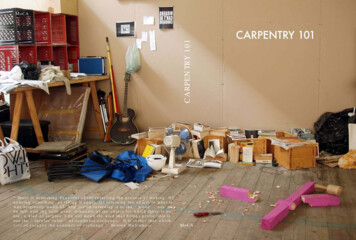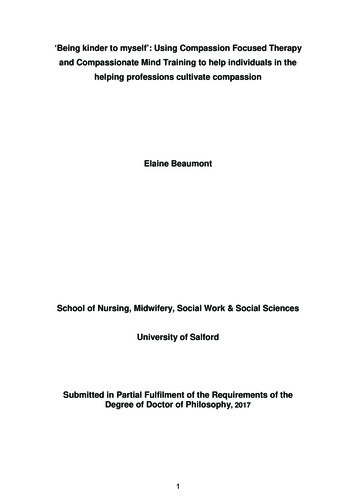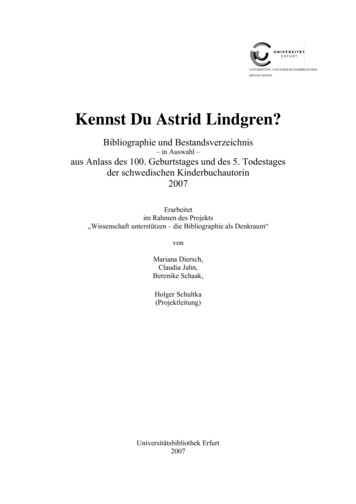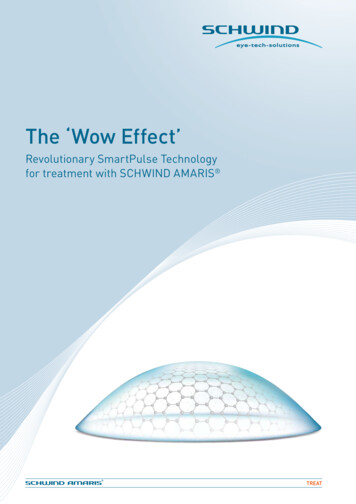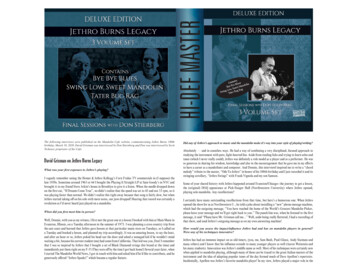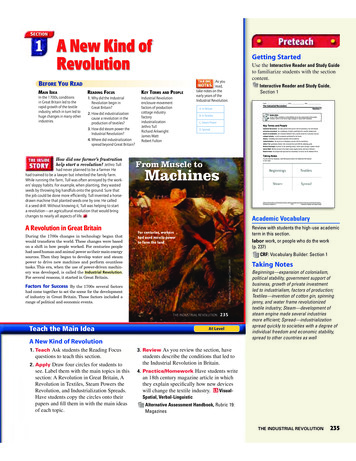
Transcription
SECTION1 A New Kind ofRevolutionGetting StartedBEFORE YOU READMAIN IDEAREADING FOCUSKEY TERMS AND PEOPLEIn the 1700s, conditionsin Great Britain led to therapid growth of the textileindustry, which in turn led tohuge changes in many otherindustries.1. Why did the IndustrialRevolution begin inGreat Britain?2. How did industrializationcause a revolution in theproduction of textiles?3. How did steam power theIndustrial Revolution?Industrial Revolutionenclosure movementfactors of productioncottage industryfactoryindustrializationJethro TullRichard ArkwrightJames WattRobert Fulton4. Where did industrializationspread beyond Great Britain?5SE THE Interactive Reader and Study GuideTO FAMILIARIZE STUDENTS WITH THE SECTIONCONTENT As youread,take notes on theearly years of theIndustrial Revolution.Interactive Reader and Study Guide,Section 1Name Class DateThe Industrial RevolutionA. In BritainSection 1B. In TextilesMAIN IDEAIn the 1700s, conditions in Great Britain led to the rapid growth of the textileindustry, which in turn led to huge changes in many other industries.C. Steam PowerKey Terms and PeopleIndustrial Revolution the time period when power-driven machinery was developedD. Spreadenclosure movement the combining of many small farms by wealthy landownersfactors of production the essential elements that a nation needs for economic successcottage industry a craft occupation performed in the homefactory a building that housed machine-driven industryindustrialization the process of changing to power-driven machineryJethro Tull gentleman farmer who invented the seed drill for planting grainRichard Arkwright inventor of the spinning frame, which spun stronger, thinner threadJames Watt British inventor who made steam engines faster and more efficientRobert Fulton developed and operated the steamship Clermont on the Hudson RiverTaking NotesHow did one farmer’s frustrationhelp start a revolution? Jethro Tullhad never planned to be a farmer. Hehad trained to be a lawyer but inherited the family farm.While running the farm, Tull was often annoyed by the workers’ sloppy habits. For example, when planting, they wastedseeds by throwing big handfuls onto the ground. Sure thatthe job could be done more efficiently, Tull invented a horsedrawn machine that planted seeds one by one. He calledit a seed drill. Without knowing it, Tull was helping to starta revolution—an agricultural revolution that would bringchanges to nearly all aspects of life.As you read the summary, add information about the Industrial Revolutionto this chart.From Muscle toMachinesOriginal content Copyright by Holt, Rinehart and Winston. Additions and changes to the original content are the responsibility of the instructor.Full Survey Chapter 21Review with students the high-use academicterm in this section.labor work, or people who do the work(p. 237)For centuries, workershad used muscle powerto farm the land.The Mowers, by Sir George Clausen, 1891CRF: Vocabulary Builder: Section 1Factors for Success By the 1700s several factorshad come together to set the scene for the developmentof industry in Great Britain. Those factors included arange of political and economic events.THE INDUSTRIAL REVOLUTIONTeach the Main Idea235At LevelA New Kind of Revolution1. Teach !SK STUDENTS THE 2EADING &OCUSQUESTIONS TO TEACH THIS SECTION 2. Apply RAW FOUR CIRCLES FOR STUDENTS TOSEE ,ABEL THEM WITH THE MAIN TOPICS IN THISSECTION ! 2EVOLUTION IN 'REAT "RITAIN !2EVOLUTION IN 4EXTILES 3TEAM 0OWERS THE2EVOLUTION AND )NDUSTRIALIZATION 3PREADS (AVE STUDENTS COPY THE CIRCLES ONTO THEIRPAPERS AND lLL THEM IN WITH THE MAIN IDEASOF EACH TOPIC Interactive Reader and Study GuideAcademic VocabularyA Revolution in Great BritainDuring the 1700s changes in technology began thatwould transform the world. These changes were basedon a shift in how people worked. For centuries peoplehad used human and animal power as their main energysources. Then they began to develop water and steampower to drive new machines and perform countlesstasks. This era, when the use of power-driven machinery was developed, is called the Industrial Revolution.For several reasons, it started in Great Britain.247Taking NotesBeginnings—expansion of colonialism,political stability, government support ofbusiness, growth of private investmentled to industrialism, factors of production;Textiles—invention of cotton gin, spinningjenny, and water frame revolutionizedtextile industry; Steam—development ofsteam engine made several industriesmore efficient; Spread—industrializationspread quickly to societies with a degree ofindividual freedom and economic stability,spread to other countries as well3. Review !S YOU REVIEW THE SECTION HAVESTUDENTS DESCRIBE THE CONDITIONS THAT LED TOTHE )NDUSTRIAL 2EVOLUTION IN "RITAIN 4. Practice/Homework (AVE STUDENTS WRITEAN TH CENTURY MAGAZINE ARTICLE IN WHICHTHEY EXPLAIN SPECIlCALLY HOW NEW DEVICESWILL CHANGE THE TEXTILE INDUSTRY VisualSpatial, Verbal-LinguisticAlternative Assessment Handbook, Rubric 19:MagazinesTHE INDUSTRIAL REVOLUTION235
Exploration and colonialism Great Britainclaimed colonies around the world that provided vast amounts of raw materials, such ascotton fiber. In addition, the colonies becamenew markets for British goods. (However,India’s own textile industry was severelydamaged by British competition.) Seapower Britain could bring in raw materials and send finished goods around the worldbecause it had the largest, most powerfulnavy and merchant fleet in the world. Political stability Although Great Britainfought wars in Canada and North Americaduring the 1700s, at home the country wasat peace, and commerce thrived. Government support Parliament passed lawsthat favored business, helping the countrycompete successfully against other nations. Growth of private investment Private businesses funded experiments for creatingbetter products—what we would call“research and development” today.Reading FocusWhy did the Industrial Revolution beginin Great Britain? colonies providedraw materials, political stabilityencouraged commerce, powerful navydefended shipping, government supported business, agricultural factors,factors of productionA Revolution inGreat BritainRecall 7HERE DID MANY OF "RITAIN SRAW MATERIALS COME FROM coloniesheld by BritainMake Inferences 7HY DO YOUTHINK RICH FARMERS EXPERIMENTED WITHAGRICULTURAL METHODS possible answers—to farm more efficiently, to findways to increase crop yieldsSummarize 7HY WAS WATER INITIALLYMORE IMPORTANT TO "RITAIN S GROWINGINDUSTRY THAN COAL OR IRON Water wasreadily available; it did not have tobe mined or transported; waterwaysprovided transportation among mines,factories, and markets.Info to KnowEnclosure Movement 4HE ENCLOSUREMOVEMENT GREATLY CHANGED RURAL%NGLAND AS COMMUNAL USE AND CARE OFTHE LAND CHANGED TO PRIVATE OWNERSHIP !S INDIVIDUAL LANDOWNERS AND TENANTSTOOK CONTROL OF DElNED AREAS OF LANDCOMMUNITIES LOST THEIR LAND USE RIGHTS /PEN UNFENCED lELDS AND MEADOWSWERE TURNED INTO PRIVATELY OWNEDHEDGED FENCED OR WALLED lELDS !CTSOF 0ARLIAMENT AS WELL AS PRIVATE AGREEMENTS BETWEEN LORDS AND THEIR TENANTSHELPED SPEED THE CHANGE H ISTORYand EconomicsFactors of ProductionThe basic factors of production are the essentialelements that a nation needs to achieve economic success. They are land (natural resources),labor, and capital. The places where these factorscan be found change over time.Factors of Production in History In the1700s the factors of production that sparked theIndustrial Revolution were all in place in GreatBritain. From these factors—coal, iron ore, waterways, unemployed farmers, cash, and human talent—the British built an industrial empire.Factors of Production Today Much haschanged since the 1700s. The land, labor, andcapital that made Great Britain an industrialleader no longer have the same value. For example, running water is not as important a powersource as it once was. Today, the industrial worlddepends more on fossil fuels, especially oil. Countries other than Great Britain provide most of the236236All these shifts in where the factors of productionare located affect wealth and, therefore, politicalpower. As you study different countries, keep trackof how the factors of production have affectedtheir economies—and their histories.A worker inMalaysia assemblesTVs for a Japanesecompany.1. Summarize How has the location of thefactors of production changed in current times?2. Predict How might the factors of productioncontinue to change?Differentiating InstructionBelow LevelSpecial Education Students;Learners Having Difficulty1. 2EVIEW WHAT THE TERM industrialization MEANSHistory and Economics 1. fossilfuels not found in Britain, skilled laborsupply from China and India, investorsfrom Asia and Middle East; 2. possibleanswer—renewable power sources,more emphasis on technically skilledworkforceworld’s supply of the precious fuel. Labor resourcescan also be found elsewhere. Today, China andIndia have huge numbersof skilled workers. Capital resources have shifted,too. Investors from Asia and the Middle East nowfund many factories in Western countries.CHAPTER 7Materials: CONSTRUCTION PAPER MARKERSAnswersAgricultural Factors Much of the researchand development took place on farms as someof Britain’s so-called gentlemen farmers beganto experiment with agricultural methods.Jethro Tull was among these wealthier farmers. In about 1701 Tull invented the seed drill,a machine that made planting grain muchmore efficient.Farmers experimented with other aspectsof agriculture also. For example, they improvedlivestock breeding methods to raise healthieranimals. Better varieties of food crops, such aspotatoes, were developed. These improvementsincreased Britain’s food supply. Since more foodcan support more people, Britain’s populationgrew rapidly.Another agricultural development hadmixed results. Wealthy landowners could buyup fields that had previously been shared byrich and poor farmers alike. The new landowners combined the small fields to create largefarms and fenced them, a transformationINDUSTRIAL SUCCESS 4HERE SHOULD BE A HOMEPAGE AND A SEPARATE PAGE FOR EACH FACTOR 0AGES SHOULD INCLUDE TEXT AND A PICTURE ORICON THAT ILLUSTRATES THE FACTOR AND THEN GUIDE STUDENTS IN A DISCUSSION OF"RITAIN S FACTORS FOR SUCCESS IN INDUSTRIALIZATION 4. (AVE VOLUNTEERS SHARE THEIR PAGES WITH THE-AKE A LIST OF "RITAIN S lVE FACTORS FORCLASS Visual-SpatialINDUSTRIAL SUCCESS FOR STUDENTS TO SEE Alternative Assessment Handbook, Rubric 3:2. /RGANIZE STUDENTS INTO MIXED ABILITY PAIRS 3. (AVE EACH PAIR DESIGN A SERIES OF 7EB PAGESTHAT EXPLAIN THE lVE FACTORS OF "RITAIN SArtwork
Britain’s Big Advantage These conditionsall point to the basic reason why the IndustrialRevolution began in Great Britain. The countryhad the essential elements that a nation needsto achieve economic success—what economistscall the factors of production. There are threefactors: land, labor, and capital.Land, in this context, means all of a place’snatural resources. Great Britain had all theresources it needed for industry. It had coal toburn as fuel and iron to make into steel andmachinery. But to get industry started, noresource was more important than water. People used Britain’s streams and rivers to turnwaterwheels and generate power, and manyof those same waterways provided transportation between mines, factories, and markets. Anetwork of canals connected major rivers. In the mid-1700s England already hadabout 1,000 miles of canals, which grew toabout 4,000 miles by 1800. Also, for longdistance shipping, Great Britain had gooddeepwater harbors.For labor, Britain had the growing population made possible by a greater food supply.Within this growing population were the thousands of people who had lost their farmlandbecause of the enclosure movement. Thesewere often entire families, and entire familieswould go to work in industry.Britain’s last factor of production wascapital, which refers to funds for investment inbusiness. The country was generally prosperous, and people had money to spend. Britainalso had “human capital”—people with abilities and skills that are needed in industry. Forexample, Jethro Tull and later inventors wereamong this group of capable people. With allthese factors of production in place, Great Britain was ready for a boom in business.Find the Main Idea Whywas Great Britain in the 1700s ideally suited to be thebirthplace of the Industrial Revolution?New Machines for an Old IndustryThe inventors who revolutionized the textileindustry improved on each other’s ideas. Thespinning frame shownhere, invented by RichardArkwright, twisted fiberstogether. As a result, itmade thread that wasmuch stronger than threadmade by an earlier machine.Reading FocusHow did industrialization cause arevolution in the production of textiles?new devices allowed faster and lesslabor-intensive production of clothA Revolution in TextilesExplain 7HY DID THE SUPPLY OF WOOLThe Granger Collection, New Yorcalled the enclosure movement. The movementallowed for more efficient farming methodsand, therefore, further increased the food supply. However, enclosure also threw countlessfarmers off the land. Unable to make a livingin the countryside, these poor farmers went tothe cities for jobs. There they would form theworkforce for growing industries.A Revolution in TextilesThe Industrial Revolution began with the British cloth-making, or textile, industry. Britishworkers had been handweaving woolen clothfor centuries. Weaving was a cottage industry—a craft occupation performed in the home. Butthe old ways of making cloth were completelytransformed by industrialization, or the processof changing to power-driven machinery.ACADEMICVOCABULARYlabor work, orpeople who do theworkAND COTTON INCREASE IN THE Senclosure movement converted farmsto pastures for more sheep, cottoncame from British colonies, includingthose in AmericaIdentify Cause and Effect(OW DID "RITAIN S DEMAND FOR COTTONAFFECT THE 5NITED 3TATES made growingcotton very profitable; increased thespread of slavery in the American SouthQuick Facts Transparency: NewMachines for an Old IndustryCRF: Primary Source: MachinesTransform the English Textile IndustryA New Way of Making Cloth In GreatBritain most fabric was made of wool or cotton. During the 1700s the supply of bothfibers increased. The wool supply increasedbecause the enclosure movement convertedso many farms to pastures for raising moresheep. Shipments of cotton fiber came from theBritish colonies, particularly in India and NorthAmerica. In the southern American coloniesthe trade in cotton had a tragic result. Slavelabor helped make cotton farming more profitable. Therefore, as Great Britain bought moreand more American cotton, slavery becamemore entrenched throughout the South.A new invention also helped keep the Americancotton industry—and slavery—profitable.THE INDUSTRIAL REVOLUTIONSkills Focus: Identifying Main Idea and Details237At LevelReading SkillLand, Labor, Capital1. RAW THE CHART BELOW FOR STUDENTS TO SEE /MIT THE ITALICIZED ANSWERS 2. (AVE STUDENTS COPY AND COMPLETE THE CHART Visual-SpatialAnswersAlternative Assessment Handbook, Rubric 7: ChartsFactors of Production in BritainFactor of ProductionLandLaborCapitalwhat it meansall natural resourcespeople available to work funds for investmenthow it was anadvantagehad coal for fuel, ironfor steelgrowing population,people who had lostfarmlandcountry prosperous,money to spend, peoplewith abilitiesReading Check Colonies around theworld supplied raw materials, powerfulnavy and merchant fleet facilitatedtrade, waterways provided power andtransportation, enclosure movement ledto large labor supply, private investorsprovided funds for investment, coal andiron deposits provided needed resources.237
Readinglike aReading FocusA Revolution in TextilesRecall 7HAT PROBLEM DID %LI 7HITNEYSOLVE the slow, tedious process of pulling seeds from raw cotton; invented thecotton ginIdentify 7HAT MACHINES WEREDEVELOPED TO SPIN lBER INTO THREAD ORYARN spinning jenny, spinning frameEvaluate ID INVENTORS LIKE AY AND!RKWRIGHT DESERVE TO BE HONORED ORSCORNED possible answers—honored:their inventions changed the world;scorned: many people lost their jobsWeavers Wanted (AVESTUDENTS DESIGN A h*OBS 7ANTEDv mYERINVITING WORKERS TO LEAVE THEIR FARMSAND COME TO WORK AT A WEAVING FACTORY 2EMIND STUDENTS THAT MANY FARMWORKERS MIGHT NOT HAVE BEEN ABLE TOREAD OR WRITE AT THIS TIME IN HISTORY HistorianAnalyzing Secondary Sources Historians often read whatother historians before them had to say. Using older sources,modern historians can learn how events were viewed in thepast. However, historians who wrote about events soon afterthey happened usually had a different perspective than historians who wrote many years after the event.The quotation here is from a British historian. When hewas writing, the textile industry had already been thoroughlymechanized.SkillsFOCUSREADING LIKE A HISTORIAN1. Credibility Would Baines be an authority on thelong-term effects of industrialization? Why or why not?2. Details What details show the author’s attitudeabout the textile industry?Reading Like a HistorianAnalyze !SK STUDENTS HOW THEY THINK"AINES MIGHT HAVE DESCRIBED PREINDUSTRIAL METHODS OF PRODUCTION primitive, backward238238The lower prices would have long-term results,but Baines could not predict them all at thisearly stage in the Industrial Revolution.Nevertheless, the ever-faster spinningmachines soon created a demand for betterweaving machines. To meet that demand, in1785 Edmund Cartwright patented the powerloom, a larger, faster weaving system.Cloth-Making in Factories The newmachines were too big for the weaver’s cottage. They had to be housed in large buildingsconstructed specially for that purpose. A building that housed industrial machines becameknown as a factory, from the old word manufactory. Factories needed ready supplies ofpower. Arkwright built early factories to housea spinning system driven by water power. Hissystem was known as the water frame.From this flurry of invention and innovation,an industry was born. In 1770 England producedabout 50,000 bolts of cloth. By 1800 the textileoutput had increased to 400,000 bolts.Identify Problem andSolution How did machines solve problems thatweavers faced?CHAPTER 7Skills Focus: Making Oral PresentationsAt LevelResearch RequiredReading Like a Historian SkillInventors Showcase1. !SSIGN EACH STUDENT THE ROLE OF AN INVENTORReading Like a Historian 1. possibleanswer—No, Baines could not have understood the long-term effects during his ownlifetime. 2. positive adjectives, general toneReading Check spinning jenny andspinning frame spun thread into yarn,“flying shuttle” and power loom madeweaving faster—E. Baines, History of the Cotton Manufacture in Great Britain,London, 1835Pulling seeds from raw cotton blossomswas time-consuming when done by hand. AnAmerican named Eli Whitney solved the problem. He built a machine, called the cotton gin,that removed the seeds efficiently.The fiber was then spun into thread oryarn. James Hargreaves, a weaver, revolutionized the spinning process with a machine hecalled the spinning jenny, which spun severalthreads at once. Hargreaves’ machine was notperfect. The thread it produced was still thickand prone to break when woven into cloth.Richard Arkwright, another inventor, solvedthis problem with the spinning frame, whichspun stronger, thinner thread.Finally, the thread was woven into fabric.The traditional in-home weaving loom wasabout six feet wide—the width a man couldreach from side to side to push the thread backand forth on a shuttle. The “flying shuttle,” patented by John Kay, doubled the speed at whicha weaver could do the job. Because many workers lost their jobs as a result, Kay was attackedand fled to France. He died in poverty.CRF: Biography: Nobert RillieuxAnswersWhen this admirable series of machines wasmade known, and by their means yarns wereproduced far superior in quality to any beforespun in England, as well as lower in price, amighty impulse was communicated to the cotton manufacture. Weavers could now obtainan unlimited quantity of yarn at a reasonableprice; manufacturers could use warps of cotton,which were much cheaper than the linen warpsformerly used. Cotton fabrics could be sold lowerthan had ever before been known.See Skills Handbook, p. H30Visual-Spatial)F STUDENTS HAVE TROUBLE GRASPINGTHE CHANGES BROUGHT BY THE )NDUSTRIAL 2EVOLUTION ASK THEM TO NAMEPRODUCTS THAT HAVE REVOLUTIONIZEDTHEIR LIVES SUCH AS CELL PHONESAND OTHER TECHNOLOGICAL DEVICESTHAT THEY CONSIDER NECESSITIES Notice the adjectives the authorused to describe the textile industry,starting with “admirable.”An Early Historian onthe Textile IndustryMENTIONED IN THE SECTION SUCH AS *ETHRO 4ULL*AMES (ARGREAVES OR 2OBERT &ULTON 2. (AVE EACH STUDENT CONDUCT OUTSIDE RESEARCHON THE ASSIGNED PERSON AND HIS MOST FAMOUSINVENTION 3. (AVE STUDENTS PREPARE AND PRESENT SHORT lRSTPERSON ACCOUNTS OF THEIR ASSIGNED INVENTOR SMOST FAMOUS INVENTION 3TUDENTS SHOULD GIVESOME BACKGROUND ON WHY THEY CREATED THEDEVICE AND DEMONSTRATE HOW IT WORKS WITHDRAWINGS OR MODELS 4. (OLD AN )NVENTORS 3HOWCASE IN WHICHSTUDENTS PRESENT THEIR INVENTIONS Intrapersonal, KinestheticAlternative Assessment Handbook, Rubrics 24:Oral Presentations; and 30: Research
Steam Powers the RevolutionA simple fact of physics powered the Industrial Revolution: when water is heated andchanges into steam, it expands. British inventors learned how to harness the force of steamto drive machines that transformed the world.Development of the Steam Engine Thefirst commercially successful steam engine wasbuilt in England in 1712, but it was very slow.Then an inventor named James Watt came upwith crucial innovations. His engine was fasterand more efficient at driving machinery. By1800 about 500 of Watt’s steam engines werechugging and hissing in mines and factoriesthroughout Britain.The widespread use of steam engines beganwhen inventors put them to use in the textilemills. Using steam power instead of waterpower meant that factories no longer had tobe built near ready supplies of water. Instead,they could be located where fuel was readilyavailable and where workers already lived.Also, factories could be built closer to roads andports from which raw materials and finishedproducts could be shipped.Steam was soon applied to other uses,eventually producing a revolution in transportation. In about 1802 Richard Trevithick useda steam engine to power the first locomotive.Steam-powered trains soon became essentialto the Industrial Revolution. They made possible the fast shipment of finished goods evento faraway markets.Steam also provided a power source forships. An Irish-born American, Robert Fulton,became famous for developing a steamshipcalled the Clermont. In 1807 the Clermontbegan operating on the Hudson River betweenNew York City and Albany. Fulton’s businesswas the first profitable use of steam navigation. Steamships would replace sailing shipson the open sea and the horse-drawn bargesthat hauled goods along canals.Coal for British Steam Engines Steamengines required immense amounts of fuel toheat water. Wood was scarce, though, becausemost of England’s forests had been cut downfor farming. But the country had a big supplyof another valuable fuel—coal. Consequently,as more factories were built to run on steam,the coal mining industry in northern and western England grew. By 1800, Great Britain produced 80 percent of Europe’s coal.Naturally, many factories were built nearBritain’s northern coal mines. Quiet agricultural landscapes changed into busy, noisy boomtowns dotted with factories and surrounded byendless rows of workers’ and miners’ homes.The miners’ families often experiencedtragedy. Working in the mines was a dangerous job. Mine explosions, coal dust, collapsingshafts, and the sheer hard labor took a heavytoll. Children were often hired to slip down thenarrow shafts and pick and haul coal. Theirlives were hard, as one account describes:Coal is still a majorresource for theUnited Kingdom,which is thefifth-greatest coalproducer in theEuropean Union.How did steam power the IndustrialRevolution? British inventors harnessed the force of steam to drivesteam engines, first in textile mills,then in trains and steamships.Steam Powers theRevolutionHISTORY’S VOICESchildren, boys and girls, earned their wages“byThedrawingthe coals in tubs along the galleries bymeans of a belt and chain, which passed aroundtheir waists. Many girls were thus employed, andafter a time became crooked and deformed.”—Carelton Smith, visitor to the Lancashire mines, 1833Such reports caught the public’s attention.Industrialization continued for some time,though, before the situation changed.Make GeneralizationsWhat impact did the steam engine have on the growthof British industry?FACES OF HISTORYAs a young man, Wattwas an instrumentmaker at Scotland’sGlasgow University.There he was given an1736–1819early steam engine torepair. It was a slow contraption that wasted fuel. One day in 1765,as Watt strolled across the campus, he got an idea for how to improvethe old engine. Watt built his new engine in secrecy, patented hisdesign, and began manufacturing it. The engine was very popular andset off a revolution in the production of textiles, paper, and flour, inmining, and in transportation. Thanks to his steam engine and otherinventions, Watt became rich and famous. Today in Glasgow, a stonemarks the place where young Watt had his “Aha!” moment—thespark of inspiration that helped launch the Industrial Revolution.A tribute to James Watt can be found on every light bulb in yourhome. The inventor played such a central role in the development ofpower generation that today we measure electric power in watts.Identify Problem and Solution How did James Watt make sure thathe would profit from his valuable design?JamesWATTTHE INDUSTRIAL REVOLUTIONSkills Focus: Identifying Cause and EffectReading Focus239At LevelReading SkillRecall 7HAT WAS *AMES 7ATT S MAINACHIEVEMENT built a more efficientsteam engineSummarize (OW DID THE STEAMENGINE LEAD TO A REVOLUTION IN TRANSPORTATION Steam-powered trains made itpossible to ship goods quickly; steampowered ships replaced sailing shipsand slow horse-drawn barges.Evaluate #OULD COAL MINING HAVEBEEN MADE MORE HUMANE possibleanswers—Yes, children should nothave been used for mine work; no,mine work is very dangerous anddifficult, even today.Info to KnowWatt’s Designs *AMES 7ATT S IMPROVEDSTEAM ENGINE RELIED ON A CONDENSINGCHAMBER THAT WOULD PREVENT THE LOSSOF STEAM FROM THE SYSTEM )T WASTYPICALLY USED TO WORK PUMPS )N HE INVENTED THE ROTARY ENGINE WHICHDROVE MACHINERY BY TURNING A SHAFT INTHE MACHINE 7HILE THESE DESIGNS WEREUNDER PATENT THE lRM OF "OULTON AND7ATT BUILT ABOUT STEAM PUMPS ANDOVER ROTARY ENGINES URING HISCAREER 7ATT ALSO INVENTED THE DOUBLEACTING ENGINE AND A PRESSURE GAUGE Effects of Steam Power1. 2EVIEW THE INFORMATION IN THE TEXT ABOUT THEDEVELOPMENT OF STEAM POWER AND ITS EFFECTS 2. -AKE A TWO COLUMN CHART TITLED %FFECTSOF 3TEAM 0OWER FOR STUDENTS TO SEE ,ABELONE COLUMN 0OSITIVE AND THE OTHER COLUMN.EGATIVE 3. (AVE VOLUNTEERS lLL IN THE CHART WITH POSITIVEAND NEGATIVE EFFECTS OF BOTH THE DEVELOPMENTAND USE OF STEAM POWER 4. 'UIDE STUDENTS IN A DISCUSSION ABOUT THEPOSITIVE EFFECTS FOR WORKERS FACTORY OWNERSAND MERCHANTS 7OULD IT HAVE BEEN POSSIBLETO LESSEN THE NEGATIVE EFFECTS AND STILL GET ALLVisual-SpatialTHE POSITIVE ONESAlternative Assessment Handbook, Rubric 7:ChartsAnswersFaces of History built engine insecrecy, patented his designReading Check major impact; used intextile mills, factories could be locatedaway from rivers, powered locomotivesand ships, led to development of coalas a resource, more factories built nearnorthern coal mines239
Industrialization SpreadsWith steam driving British factories, industrialization increased rapidly and soonspread to western Europe and the UnitedStates. Other regions, including Asia andAfrica, did not industrialize in the 1800s. Whydid industry not take hold in some areas?What was it about Western countries thatencouraged them to embrace industry?Reading FocusWhere did industrialization spreadbeyond Great Britain? America,continental Europe, AsiaIndustry and the West Today’s scholarsIndustrialization Spreadshave many ideas about why industrializationdid not spread quickly to all parts of the world.Among those ideas is the impact of individualfreedom on economic activity.In Western countries, individual freedomwas becoming a significant force in society.Although during the 1800s even Westerncountries were not truly democratic, the individual citizens enjoyed more political libertythan people elsewhere. People with a degree offreedom can compete against each other. Western societies saw competition as good. Wealthand fame rewarded those who competed well.For example, explorers raced to find new landswhere merchants could do business. Fierce competition even led some Westerners to exploitother countries in their search for raw materials and markets. Then, during the IndustrialRevolution, Western industrialists competed toimprove on inventions and processes.Explain (OW DID "RITAIN TRY TO KEEPITS DISCOVERIES SECRET outlawed exportof certain machines, forbade skilledcraftsmen from leaving the countryMake Inferences 7HAT DO 3AMUEL3LATER S ACCOMPLISHMENTS REVEAL ABOUTHIM possible answer—that the wastechnically skilled, highly motivated,and had a good memoryInfo to KnowBiographyWilliam Blake (1757–1827) 7ILLIAM"LAKE WAS A "RITISH ARTIST AND POET WHODElED CONVENTION !PPRENTICED TO ANENGRAVER HE DREW COPIES OF MONUMENTSIN ,ONDON S CHURCHES !FTER TRYINGUNSUCCESSFULLY TO ESTABLISH A PRINTSHOP "LAKE MADE A MODEST LIVING AS ANENGRAVER AND ILLUSTRATOR (E DEVELOPED AMETHOD OF hILLUMINATED PRINTING v WHICHCOMBINED ART AND TEXT
THE INDUSTRIAL REVOLUTION 235 A New Kind of Revolution BEFORE Y OU R EAD How did one farmer’s frustration help start a revolution? Jethro Tull had never planned to be a farmer. He had trained to be a lawyer but inherited the family farm. While running the farm, Tull was often anno




